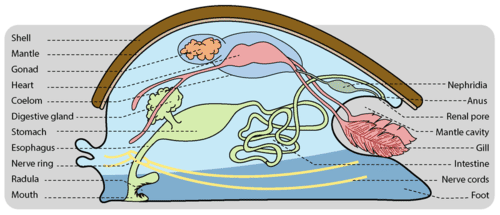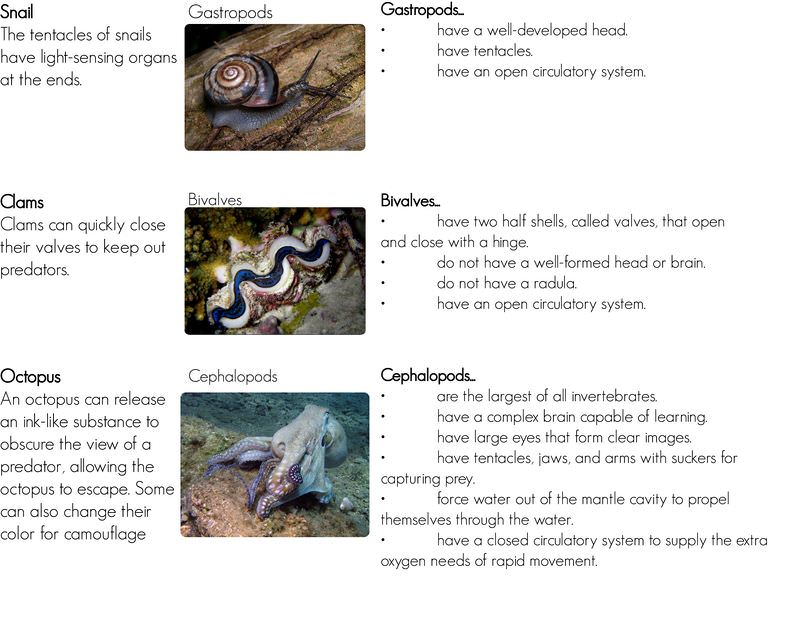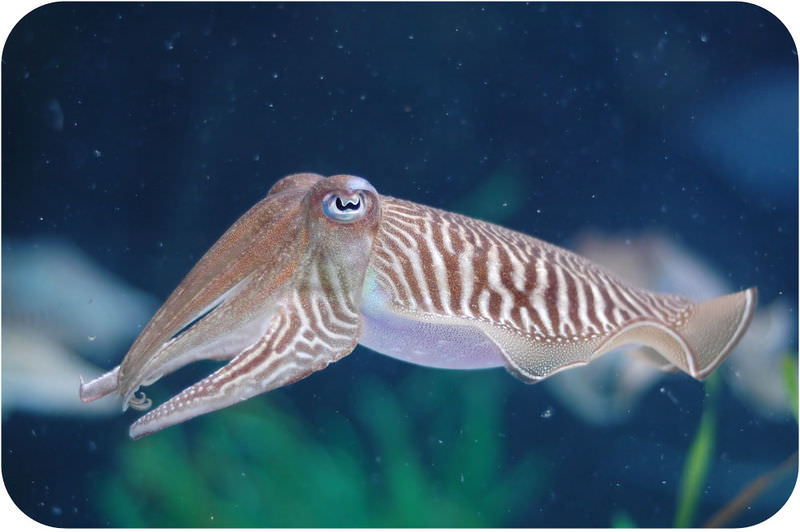11.12: Mollusks
- Page ID
- 12255
\( \newcommand{\vecs}[1]{\overset { \scriptstyle \rightharpoonup} {\mathbf{#1}} } \)
\( \newcommand{\vecd}[1]{\overset{-\!-\!\rightharpoonup}{\vphantom{a}\smash {#1}}} \)
\( \newcommand{\dsum}{\displaystyle\sum\limits} \)
\( \newcommand{\dint}{\displaystyle\int\limits} \)
\( \newcommand{\dlim}{\displaystyle\lim\limits} \)
\( \newcommand{\id}{\mathrm{id}}\) \( \newcommand{\Span}{\mathrm{span}}\)
( \newcommand{\kernel}{\mathrm{null}\,}\) \( \newcommand{\range}{\mathrm{range}\,}\)
\( \newcommand{\RealPart}{\mathrm{Re}}\) \( \newcommand{\ImaginaryPart}{\mathrm{Im}}\)
\( \newcommand{\Argument}{\mathrm{Arg}}\) \( \newcommand{\norm}[1]{\| #1 \|}\)
\( \newcommand{\inner}[2]{\langle #1, #2 \rangle}\)
\( \newcommand{\Span}{\mathrm{span}}\)
\( \newcommand{\id}{\mathrm{id}}\)
\( \newcommand{\Span}{\mathrm{span}}\)
\( \newcommand{\kernel}{\mathrm{null}\,}\)
\( \newcommand{\range}{\mathrm{range}\,}\)
\( \newcommand{\RealPart}{\mathrm{Re}}\)
\( \newcommand{\ImaginaryPart}{\mathrm{Im}}\)
\( \newcommand{\Argument}{\mathrm{Arg}}\)
\( \newcommand{\norm}[1]{\| #1 \|}\)
\( \newcommand{\inner}[2]{\langle #1, #2 \rangle}\)
\( \newcommand{\Span}{\mathrm{span}}\) \( \newcommand{\AA}{\unicode[.8,0]{x212B}}\)
\( \newcommand{\vectorA}[1]{\vec{#1}} % arrow\)
\( \newcommand{\vectorAt}[1]{\vec{\text{#1}}} % arrow\)
\( \newcommand{\vectorB}[1]{\overset { \scriptstyle \rightharpoonup} {\mathbf{#1}} } \)
\( \newcommand{\vectorC}[1]{\textbf{#1}} \)
\( \newcommand{\vectorD}[1]{\overrightarrow{#1}} \)
\( \newcommand{\vectorDt}[1]{\overrightarrow{\text{#1}}} \)
\( \newcommand{\vectE}[1]{\overset{-\!-\!\rightharpoonup}{\vphantom{a}\smash{\mathbf {#1}}}} \)
\( \newcommand{\vecs}[1]{\overset { \scriptstyle \rightharpoonup} {\mathbf{#1}} } \)
\( \newcommand{\vecd}[1]{\overset{-\!-\!\rightharpoonup}{\vphantom{a}\smash {#1}}} \)
\(\newcommand{\avec}{\mathbf a}\) \(\newcommand{\bvec}{\mathbf b}\) \(\newcommand{\cvec}{\mathbf c}\) \(\newcommand{\dvec}{\mathbf d}\) \(\newcommand{\dtil}{\widetilde{\mathbf d}}\) \(\newcommand{\evec}{\mathbf e}\) \(\newcommand{\fvec}{\mathbf f}\) \(\newcommand{\nvec}{\mathbf n}\) \(\newcommand{\pvec}{\mathbf p}\) \(\newcommand{\qvec}{\mathbf q}\) \(\newcommand{\svec}{\mathbf s}\) \(\newcommand{\tvec}{\mathbf t}\) \(\newcommand{\uvec}{\mathbf u}\) \(\newcommand{\vvec}{\mathbf v}\) \(\newcommand{\wvec}{\mathbf w}\) \(\newcommand{\xvec}{\mathbf x}\) \(\newcommand{\yvec}{\mathbf y}\) \(\newcommand{\zvec}{\mathbf z}\) \(\newcommand{\rvec}{\mathbf r}\) \(\newcommand{\mvec}{\mathbf m}\) \(\newcommand{\zerovec}{\mathbf 0}\) \(\newcommand{\onevec}{\mathbf 1}\) \(\newcommand{\real}{\mathbb R}\) \(\newcommand{\twovec}[2]{\left[\begin{array}{r}#1 \\ #2 \end{array}\right]}\) \(\newcommand{\ctwovec}[2]{\left[\begin{array}{c}#1 \\ #2 \end{array}\right]}\) \(\newcommand{\threevec}[3]{\left[\begin{array}{r}#1 \\ #2 \\ #3 \end{array}\right]}\) \(\newcommand{\cthreevec}[3]{\left[\begin{array}{c}#1 \\ #2 \\ #3 \end{array}\right]}\) \(\newcommand{\fourvec}[4]{\left[\begin{array}{r}#1 \\ #2 \\ #3 \\ #4 \end{array}\right]}\) \(\newcommand{\cfourvec}[4]{\left[\begin{array}{c}#1 \\ #2 \\ #3 \\ #4 \end{array}\right]}\) \(\newcommand{\fivevec}[5]{\left[\begin{array}{r}#1 \\ #2 \\ #3 \\ #4 \\ #5 \\ \end{array}\right]}\) \(\newcommand{\cfivevec}[5]{\left[\begin{array}{c}#1 \\ #2 \\ #3 \\ #4 \\ #5 \\ \end{array}\right]}\) \(\newcommand{\mattwo}[4]{\left[\begin{array}{rr}#1 \amp #2 \\ #3 \amp #4 \\ \end{array}\right]}\) \(\newcommand{\laspan}[1]{\text{Span}\{#1\}}\) \(\newcommand{\bcal}{\cal B}\) \(\newcommand{\ccal}{\cal C}\) \(\newcommand{\scal}{\cal S}\) \(\newcommand{\wcal}{\cal W}\) \(\newcommand{\ecal}{\cal E}\) \(\newcommand{\coords}[2]{\left\{#1\right\}_{#2}}\) \(\newcommand{\gray}[1]{\color{gray}{#1}}\) \(\newcommand{\lgray}[1]{\color{lightgray}{#1}}\) \(\newcommand{\rank}{\operatorname{rank}}\) \(\newcommand{\row}{\text{Row}}\) \(\newcommand{\col}{\text{Col}}\) \(\renewcommand{\row}{\text{Row}}\) \(\newcommand{\nul}{\text{Nul}}\) \(\newcommand{\var}{\text{Var}}\) \(\newcommand{\corr}{\text{corr}}\) \(\newcommand{\len}[1]{\left|#1\right|}\) \(\newcommand{\bbar}{\overline{\bvec}}\) \(\newcommand{\bhat}{\widehat{\bvec}}\) \(\newcommand{\bperp}{\bvec^\perp}\) \(\newcommand{\xhat}{\widehat{\xvec}}\) \(\newcommand{\vhat}{\widehat{\vvec}}\) \(\newcommand{\uhat}{\widehat{\uvec}}\) \(\newcommand{\what}{\widehat{\wvec}}\) \(\newcommand{\Sighat}{\widehat{\Sigma}}\) \(\newcommand{\lt}{<}\) \(\newcommand{\gt}{>}\) \(\newcommand{\amp}{&}\) \(\definecolor{fillinmathshade}{gray}{0.9}\)
Fish or squid?
Neither. This is a mollusk, a cuttlefish to be specific. What is a mollusk? Well, to start, mollusks are aquatic species that are not fish. There are over 100,000 different mollusks, so there are bound to be some interesting looking organisms, like this one.
Mollusks
Have you ever been to the ocean or eaten seafood? If you have, then you probably have encountered members of the phylum Mollusca. Mollusks include snails, scallops, and squids, as shown in Figure below. There are more than 100,000 known species of mollusks. About 80 percent of mollusk species are gastropods.

This figure shows some of the more common and familiar mollusks.
Structure and Function of Mollusks
Mollusks are a very diverse phylum. Some mollusks are nearly microscopic. The largest mollusk, a colossal squid, may be as long as a school bus and weigh over half a ton! The basic body plan of a mollusk is shown in Figure below. The main distinguishing feature is a hard outer shell. It covers the top of the body and encloses the internal organs. Most mollusks have a distinct head region. The head may have tentacles for sensing the environment and grasping food. There is generally a muscular foot, which may be used for walking. However, the foot has evolved modifications in many species to be used for other purposes.
 Basic Mollusk Body Plan. The basic body plan shown here varies among mollusk classes. For example, several mollusk species no longer have shells. Do you know which ones?
Basic Mollusk Body Plan. The basic body plan shown here varies among mollusk classes. For example, several mollusk species no longer have shells. Do you know which ones?Two unique features of mollusks are the mantle and radula (see Figure above). The mantle is a layer of tissue that lies between the shell and the body. It secretes calcium carbonate to form the shell. It forms a cavity, called the mantle cavity, between the mantle and the body. The mantle cavity pumps water for filter feeding. The radula is a feeding organ with teeth made of chitin. It is located in front of the mouth in the head region. Herbivorous mollusks use the radula to scrape food such as algae off rocks. Predatory mollusks use the radula to drill holes in the shells of their prey.
Mollusks have a coelom and a complete digestive system. Their excretory system consists of tube-shaped organs called nephridia (see Figure above). The organs filter waste from body fluids and release the waste into the coelom. Terrestrial mollusks exchange gases with the surrounding air. This occurs across the lining of the mantle cavity. Aquatic mollusks “breathe” under water with gills. Gills are thin filaments that absorb gases and exchange them between the blood and surrounding water.
Mollusks have a circulatory system with one or two hearts that pump blood. The heart is a muscular organ that pumps blood through the circulatory system when its muscles contract. The circulatory system may be open or closed, depending on the species.
The major classes of mollusks vary in structure and function. You can read about some of their differences in Figure below.
 Use this figure to compare and contrast gastropods, bivalves, and cephalopods
Use this figure to compare and contrast gastropods, bivalves, and cephalopodsMollusk Reproduction
Mollusks reproduce sexually. Most species have separate male and female sexes. Gametes are released into the mantle cavity. Fertilization may be internal or external, depending on the species. Fertilized eggs develop into larvae. There may be one or more larval stages. Each one is different from the adult stage. Mollusks have a unique larval form called a trochophore. It is a tiny organism with cilia for swimming.
Ecology of Mollusks
Mollusks live in most terrestrial, freshwater, and marine habitats. However, the majority of species live in the ocean. They can be found in both shallow and deep water and from tropical to polar latitudes. Mollusks are a major food source for other organisms, including humans. You may have eaten mollusks such as clams, oysters, scallops, or mussels.
The different classes of mollusks have different ways of obtaining food.
- Gastropods may be herbivores, predators, or internal parasites. They live in both aquatic and terrestrial habitats. Marine species live mainly in shallow coastal waters. Gastropods use their foot to crawl slowly over rocks, reefs, or soil, looking for food.
- Bivalves are generally sessile filter feeders. They live in both freshwater and marine habitats. They use their foot to attach themselves to rocks or reefs or to burrow into mud. Bivalves feed on plankton and nonliving organic matter. They filter the food out of the water as it flows through their mantle cavity.
- Cephalopods are carnivores that live only in marine habitats. They may be found in the open ocean or close to shore. They are either predators or scavengers. They generally eat other invertebrates and fish.
KQED: Cool Critters: Dwarf Cuttlefish
What's the coolest critter in the ocean under 4 inches long? The Dwarf Cuttlefish! Cuttlefish are marine animals that belong to the class Cephalopoda. Despite their name, cuttlefish are not fish but mollusks. Recent studies indicate that cuttlefish are among the most intelligent invertebrates, with one of the largest brain-to-body size ratios of all invertebrates. Cuttlefish have an internal shell called the cuttlebone and eight arms and two tentacles furnished with suckers, with which they secure their prey.
KQED: The Fierce Humboldt Squid
The Humboldt squid is a large, predatory invertebrate found in the waters of the Pacific Ocean. A mysterious sea creature up to 7 feet long, with 10 arms, a sharp beak and a ravenous appetite, packs of fierce Humboldt Squid attack nearly everything they see, from fish to scuba divers. Traveling in groups of 1,000 or more and swimming at speeds of more than 15 miles an hour, these animals hunt and feed together, and use jet propulsion to shoot out of the water to escape predators. Humboldt squid live at depths of between 600 and about 2,000 feet, coming to the surface at night to feed. They live for approximately two years and spend much of their short life in the ocean's oxygen-minimum zone, where very little other life exists. Because they live at such depths, little is known about these mysterious sea creatures. The Humboldt squid usually lives in the waters of the Humboldt Current, ranging from the southern tip of South America north to California, but in recent years, this squid has been found as far north as Alaska. Marine biologists are working to discover why they have headed north from their traditional homes off South America.
Where's the Octopus?
When marine biologist Roger Hanlon captured the first scene in this video, he started screaming. Hanlon, senior scientist at the Marine Biological Laboratory in Woods Hole, studies camouflage in cephalopods: squid, cuttlefish and octopuses. They are masters of optical illusion.
Science Friday: I, Octopus
With thousands of chemically-sensitive suckers, color-changing skin, and a brain that literally stretches when they eat, octopuses seem like aliens living in our oceans. In this video by Science Friday, Frank Grasso explains their physical adaptations and how octopuses might process their own sensations.
Science Friday: The Unlikely Tale of a Tenacious Snail
For over 70 years, no one had seen the oblong rocksnail. Declared extinct in 2000, the species was considered to be another native Alabaman mollusk gone and forgotten. But one day in the spring of 2011, biology grad student Nathan Whelan picked up a tiny rock and got a big surprise.
Summary
- Mollusks are invertebrates such as snails, scallops, and squids.
- Mollusks have a hard outer shell. There is a layer of tissue called the mantle between the shell and the body.
- Most mollusks have tentacles for feeding and sensing, and many have a muscular foot.
- Mollusks also have a coelom, a complete digestive system, and specialized organs for excretion.
- The majority of mollusks live in the ocean.
- Different classes of mollusks have different ways of obtaining food.
Review
- List the three major classes of mollusks.
- Describe the basic body plan of a mollusk.
- Describe the mantle and radula.
- What are gills? What is their function?
- Create a Venn diagram to show important similarities and differences among the three major classes of mollusks.
| Image | Reference | Attributions |
 |
[Figure 1] | Credit: Snail: User:Takahashi/Wikimedia Commons, Clam: Neville Wootton; Octopus: Silke Baron Source: Snail: commons.wikimedia.org/wiki/File:Euhadra_peliomphala.jpg ; Clam: http://www.flickr.com/photos/nevillewootton/9364282490/ ; Octopus: http://www.flickr.com/photos/silkebaron/4351183836/ License: CC BY-NC |
 |
[Figure 2] | Credit: Snail: Flickr:macrophile; Scallop: Dann Blackwood/US Geological Survey; Squid: Courtesy of NOAA Source: Snail: commons.wikimedia.org/wiki/File:Common_snail.jpg ; Scallop: commons.wikimedia.org/wiki/File:Placopecten_magellanicus.jpg ; Squid: commons.wikimedia.org/wiki/File:Lycoteuthidae_sp.jpg License: Snail CC BY 2.0; Scallop Public Domain; Squid Public Domain |
 |
[Figure 3] | Credit: Mariana Ruiz Villarreal (LadyofHats) for CK-12 Foundation;By WYassineMrabetTalk✉This vector image was created with Inkscape. - Own work, CC BY-SA 3.0, commons.wikimedia.org/w/inde...?curid=8062105 Source: CK-12 Foundation ; By WYassineMrabetTalk✉This vector image was created with Inkscape. - Own work ; CC BY-SA 3.0 ; commons.wikimedia.org/w/index.php?curid=8062105 License: CC BY-NC 3.0 |
 |
[Figure 4] | Credit: Snail: User:Takahashi/Wikimedia Commons, Clam: Neville Wootton; Octopus: Silke Baron Source: Snail: commons.wikimedia.org/wiki/File:Euhadra_peliomphala.jpg ; Clam: http://www.flickr.com/photos/nevillewootton/9364282490/ ; Octopus: http://www.flickr.com/photos/silkebaron/4351183836/ License: Snail Public Domain; Clam CC BY 2.0; Octopus CC BY 2.0 |

